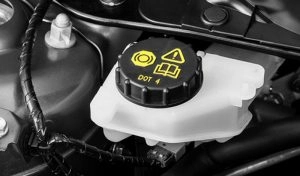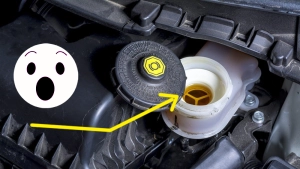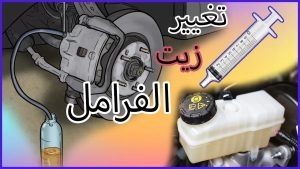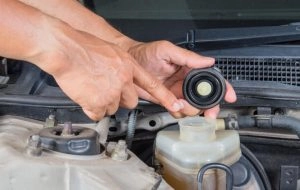Changing the brake oil is an important and necessary process to maintain the safety of the driver, passengers, and the car. Brake oil is composed of a mix of chemical substances that help to convert mechanical energy into thermal energy, thereby enabling the car to stop safely and efficiently.
Brake fluid naturally degrades and gets damaged over time, it needs to be replaced periodically to maintain the efficiency of the brake system and ensure the safety of the driver and passengers. Hence, we'll tackle everything you need to know about changing brake fluid.
When should the brake oil be changed?

The car's brake oil must be changed regularly according to the car manufacturer's recommendations, which range from once every two to five years or between 24,000 to 36,000 miles, whichever comes first.
However, this period can vary based on the make and model of the car, as well as driving conditions. Therefore, it is best to check the car owner's manual or consult a qualified mechanic to get specific recommendations about the most appropriate time to change the oil.
The Main Importance To change the brake oil Regular car maintenance involves maintaining the safety of the brake system, avoiding wear and tear of parts, and preventing the deterioration of its performance and the risk of brake failure.
Why should the brake oil be changed?

The car's brake oil should be changed regularly to ensure the brakes function correctly and to maintain driving safety. Over time, brake oil absorbs moisture, leading to the corrosion of various parts in the brake system and a decline in its performance.
Also, attention should be paid to any signs of brake oil leakage or any malfunctions in the car's brakes, and they should be checked as needed by consulting a qualified mechanic.
Steps for Changing Brake Fluid

Prepare the necessary tools and materials.
The first step in changing brake fluid involves gathering the necessary tools and materials, which you will need:
Brake Oil: The type of oil specified in the car owner's manual should be used.
Injector: For extracting the old oil from the brake oil tank and refilling with new oil.
Dry cloth or paper towels: For cleaning any residues or drops of old or new oil on the components.
Wrench or extraction tool: For removing any drain valves or air valves in the brake system.
Plastic Funnel: Used for filling the brake oil tank with new oil.
It is important to use the appropriate tools and the correct materials to ensure that the oil change process is carried out safely and efficiently.
2) Locate the brake fluid reservoir
The second step is to locate the brake fluid reservoir, which is usually found on the top part of the main brake tank under the hood of your car. The location can be easily found by consulting your car's operating manual.
There may be a symbol on the box indicating the location of the brake oil tank. Also, it is necessary to confirm the location of the brake oil tank before performing any replacement to ensure that the operation is carried out correctly and safely.
3) Removing the old oil
The third step in the process of changing brake fluid is removing the old oil from the oil tank, which can be done using an installation syringe or a syringe to draw out all the old oil from the tank.
Ensure that the injector is clean and free from dust and impurities before using it.
The injector is inserted into the brake oil tank and pressure is applied to the inner stick to extract the old oil.
Old oil should be disposed of properly by using containers for the disposal of used oil or by recycling it at recycling stations.
4) Filling with new oil
The fourth step is to fill the brake fluid reservoir with new clean oil. In this step, a plastic funnel is used to fill the brake fluid reservoir with the new oil.
Ensure that the funnel is clean and free from dust and impurities before using it.
The brake oil reservoir is slowly and carefully filled with new oil through a funnel, ensuring that no oil residue is spilled onto the paint or any other components of the car. It is important to note that the brake oil reservoir should be filled up to the maximum limit recommended in the car owner's manual.
5) Bleeding air from the brake lines
The fifth step in changing brake fluid is to bleed the air from the brake lines. This step starts from the wheel furthest from the main brake reservoir by opening the bleeder screw.
Ask another person to slowly press the brake pedal while keeping the drain valve open until the air is completely drained from the line.
When no air bubbles are seen in the brake hose, the drain valve should be closed and move on to the next wheel and repeat the same process. The procedure is repeated on each wheel until all the air has been purged from all the lines.
This step is important because the air in the brake lines can reduce brake efficiency and prevent them from responding correctly. You must ensure that there are no air bubbles in the brake lines before relying on the brakes while driving.
6) Ensure the brake fluid level

The sixth step in the process of changing brake oil is to ensure the level of brake oil after removing air from all brake lines and filling the oil tank with new oil. The oil level in the tank should be checked again. It is important to ensure that the oil level in the tank aligns with the level recommended in the car's operating manual.
If the oil level is low, the tank should be filled with new oil until it reaches the correct level. It's essential to avoid adding extra oil or overfilling the tank, as this can lead to brake system corrosion and leakage. Also, make sure to securely close the brake oil tank cap after checking the oil level.
It is important that the verification is done.Brake fluid levelRegularly ensure that the braking system is functioning efficiently for safe driving.

Comments